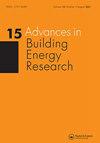Risk identification of residential energy demand: the case studies of Australia, Chile, the United Kingdom and the United States
IF 2.5
Q2 CONSTRUCTION & BUILDING TECHNOLOGY
引用次数: 0
Abstract
ABSTRACT A wide range of residential sector energy models have been developed in recent years to determine energy demand and CO2 emissions and to evaluate energy saving policies. However, modelling outputs are subject to significant variations due to multiple sources of uncertainty, primarily stemming from input parameters and assumptions. This study aims to assess the transferability of the Transferable Energy Model (TREM) and quantify the prediction uncertainty of residential sector energy demand until 2030 in four case study countries (Australia, Chile, United Kingdom and the United States). TREM is able to determine the future annual energy demand in the residential sector according to the area of energy use (space heating, hot water provision, cooking, electrical appliances, lighting), whilst quantifying uncertainties in the results. Significant variations (between −12% and +63%) in residential energy demand in the year 2030 with respect to 2010 were found among the case study countries, suggesting that single total energy demand estimates are associated with considerable uncertainties. This paper also presents a comprehensive database of the range of possible variations in residential energy demand related to a wide range of energy saving measures in each case study country.住宅能源需求的风险识别:以澳大利亚、智利、英国和美国为例
摘要近年来,人们开发了一系列住宅部门的能源模型,以确定能源需求和二氧化碳排放,并评估节能政策。然而,由于主要源于输入参数和假设的多种不确定性,建模输出可能会发生重大变化。本研究旨在评估可转移能源模型(TREM)的可转移性,并量化四个案例研究国家(澳大利亚、智利、英国和美国)2030年前住宅部门能源需求的预测不确定性。TREM能够根据能源使用领域(空间供暖、热水供应、烹饪、电器、照明)确定住宅部门未来的年度能源需求,同时量化结果中的不确定性。案例研究国家发现,与2010年相比,2030年的住宅能源需求存在显著差异(在-12%至+63%之间),这表明单一的总能源需求估计与相当大的不确定性有关。本文还提供了一个全面的数据库,记录了每个案例研究国家与各种节能措施相关的住宅能源需求的可能变化范围。
本文章由计算机程序翻译,如有差异,请以英文原文为准。
求助全文
约1分钟内获得全文
求助全文
来源期刊

Advances in Building Energy Research
CONSTRUCTION & BUILDING TECHNOLOGY-
CiteScore
4.80
自引率
5.00%
发文量
11
 求助内容:
求助内容: 应助结果提醒方式:
应助结果提醒方式:


